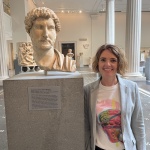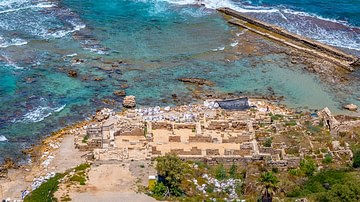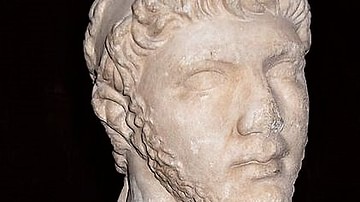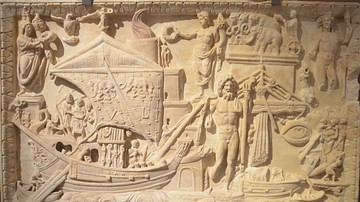Algeria, Africa's largest country, stretches from the Mediterranean coastline to the Saharan desert interior. The country has some of the finest and most diverse Roman sites, including Timgad and Djémila, both well-preserved and UNESCO-listed. Off-limits for decades, Algeria is becoming many Western travellers' favourite North African destination and a paradise for history buffs.
A Short Introduction to Roman Algeria
The territory corresponding to Algeria has been at the crossroads of history. The Phoenicians, famous navigators and traders from the Syrian-Lebanese coast, landed in Carthage in the 9th century BCE. They established ports and trading posts along the North African coast. By the 6th century BCE, a Phoenician presence existed at Tipaza (east of Cherchell), Hippo Regius (modern Annaba) and Rusicade (modern Skikda).
The Phoenician traders populated the coastline, while Berber nomadic and seminomadic tribes inhabited the interior of Algeria. The Berbers traded with the Phoenicians, and agriculture became a dominant feature of Berber society. By the 4th century BCE, Carthage controlled the North African coast and expanded the trade routes. Trade links with the local tribes continued, a small handful of Berber states grew in power, and kingdoms emerged. The two most prominent local societies were the Mauri, who joined up to form Mauretania (an area corresponding to modern Morocco) and the Numidians, who occupied the regions between the Mauri and the city-state of Carthage.
Carthaginian and Roman expansion led to conflict, and hostilities exploded into the Punic Wars (264-146 BCE). Numidian tribes supported different sides in the war. One king, Masinissa (r. c. 202-148 BCE), allied himself with Rome and took part in the Battle of Zama (202 BCE), which ended the war with Carthage's defeat. The end of the Third Punic War and the sacking of Carthage was the beginning of Roman presence in North Africa.
Rome's first province, Africa (roughly corresponding to modern Tunisia, the northeast of Algeria and the coast of western Libya), was established. Utica (near Bizerte in Tunisia) was its administrative capital. With Roman backing, Masinissa established his own kingdom of Numidia, west of Carthage, with Cirta (Constantine) as its capital. Numidia flourished under his reign and that of his son Micipsa (r. c. 148-118 BCE).
When Bocchus II of Mauretania died in 33 BCE, he bequeathed his kingdom to Rome. However, Augustus (r. 27 BCE to 14 CE) chose not to annex the country, and Mauretania became a client kingdom. He protected Rome's western border by appointing Juba II (50 BCE to 24 CE) as king of Mauretania. Juba II was a renowned scholar married to Cleopatra and Mark Antony's daughter, Cleopatra Selene II (40 BCE to c. 5 BCE)
After the murder of Juba's son, Ptolemy of Mauretania (r. 20-40 CE), c. 40 CE, the kingdom was split into two provinces: Mauretania Tingitana to the west (in modern Morocco) and Mauretania Caesariensis to the east (in modern Algeria), with its capital in Caesarea (Cherchell). Cities were founded or granted higher status, and a military presence controlled the conquered territories. By the middle of the 2nd century CE, Roman veterans had founded settlements at Tipasa (Tipaza), Cuicul (Djémila), Thamugadi (Timgad) and Sitifis (Sétif). Lambaesis was the seat of the Third Augustan Legion. The military was responsible for protecting cities and constructing roads, bringing Roman civilisation into various areas of North Africa.
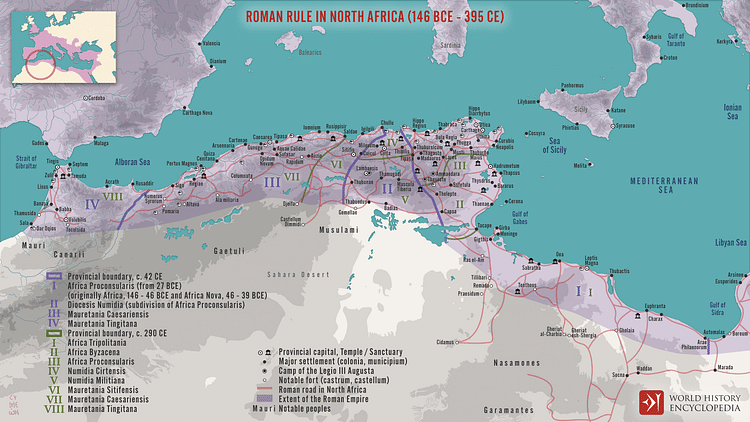
Roman culture flourished, and the North African provinces enjoyed four centuries of prosperity. Agriculture boomed as Africa supplied more than 60% of the Roman Empire's grain requirements. Most of the wild animals used in amphitheatre shows came from African ports, as well as gold, olive oil, enslaved people, ivory, and fish sauce (garum). Roman Africans began to influence Rome, and some Berbers were granted Roman citizenship.
However, Berber uprisings were frequent. Roman emperor Trajan (r. 98-117 CE) built forts surrounding the Aures Mountains in response, while his successor Hadrian (r. 117-138 CE) journeyed to North Africa in 128 CE to inspect the army. In the late 2nd century CE, a new province of Numidia was created under the emperor Septimius Severus (r. 193-211 CE), an African by birth.

Many Roman and Berber inhabitants embraced Christianity, and doctrinal schisms later gave prominence to one of the greatest of the Christian Church Fathers, Augustine of Hippo (354-430 CE). Numidia remained a Roman province after the fall of the Western Roman Empire in 476 CE. However, Roman presence weakened with the Germanic Vandals' conquest under Gaiseric (r. 428-478 CE) in 429 CE. Despite attempts by the Byzantine army to control the North African provinces after the defeats of the Vandals, the Arab invaders in the 7th century CE ended the Roman history of North Africa.

The French, who colonised Algeria in 1830 and ruled it until 1962, undertook extensive excavations and restorations of Roman remains. Some significant archaeological sites are well-preserved.
Tipasa (Tipaza)
The UNESCO World Heritage Site Tipasa is located about 70 km (43 mi) west of Algiers, Algeria's capital, on the shores of the Mediterranean. Tipasa was a Phoenician and Punic trading post on the sea route between Carthage and the Pillars of Hercules (Straits of Gibraltar). Only traces of 6th-century BCE necropolises remain from this period.
Tipasa was conquered by Rome in the 1st century CE and was a municipality with Latin rights under Claudius (r. 41-54 CE) and a colony under Hadrian or Antoninus Pius (r. 138-161 CE). The 2nd and 3rd centuries CE were a period of great prosperity for Tipasa when a vast enceinte (boundary wall) was constructed. Like other coastal cities, Tipasa embraced Christianity in the first half of the 4th century CE, when Christian basilicas were built. It gradually declined from the 6th century CE with the Arab invasion.
The main site of Tipasa is now a wooded archaeological park with vestiges extending over 70 ha (172 acres). The entrance leads to an amphitheatre, beyond which a path leads to the heart of the ancient town, where the two main streets, the paved cardo maximus and decumanus, join. The civic buildings lie east of the cardo, comprising the Forum, a 25 m (82 ft) by 50 m (164 ft) paved area that originally had porticoes on three sides and the capitol on the fourth. Here are the curia (municipal assembly) and the civil basilica. Houses stand along the shoreline, including the so-called Villa of Frescoes, a vast house of 1000 m² (10,700 sq ft) built in the mid-2nd century CE. The rooms open onto peristyles and are sometimes decorated with mosaics and frescoes.

Following the coast to the west, a religious complex developed by Christians includes two basilicas, tombs and baths. The grand basilica with seven naves was the largest Christian building in North Africa when it was finished in the 4th century CE. Inland is a theatre and a monumental semicircular fountain on the decumanus.

The small museum outside the park displays various Punic and Christian funerary steles and a mosaic depicting a captive family crouching with their hands bound.

Royal Mauritanian Mausoleum
The Royal Mausoleum of Mauretania near Tipaza was built in 3 BCE by Juba II of Numidia and his wife, Cleopatra Selene II. This tomb may have been their final resting place, but their remains have not been found.

The hilltop mausoleum is reminiscent of other Numidian tombs. However, it was also inspired by the Mausoleum of Augustus in Rome, constructed around 28 BCE. The royal mausoleum has a circular base and was originally topped with a pyramid or cone. The monument was roughly 60 m (196 ft) in diameter and 40 m (131 ft) tall.
Caesarea (Cherchell)
Cherchell in Algeria is a seaside town with a busy fishing port 20 km (12.4 mi) beyond Tipaza. It was founded around 600 BCE as a Phoenician trading post and was called Iol, but subsequent construction wiped out pre-Roman traces. The city rose to prominence during the reign of Juba II, who renamed it Caesarea in Augustus' honour.
In the Roman imperial age, it became the capital of Mauretania Caesariensis, with over 20,000 inhabitants. Like Tipasa, the city adopted Christianity (Augustine of Hippo visited in 418 CE) and became a target of the Vandals. Enjoying a brief resurgence under the Byzantines, Caesarea sank into obscurity before Muslim refugees from Andalusia revived the settlement in the 14th century CE.

Caesarea featured a circus, an amphitheatre, a theatre, Roman baths, numerous temples, and civic buildings like a basilica and an aqueduct. Not much remains, but Caesarea's glory lives on in the Archaeological Museum of Cherchell, constructed in 1908.

Museum highlights include marble busts of Juba II and Cleopatra Selene, a colossal statue of a Roman emperor, probably Augustus or Claudius, and a statue of a naked Apollo (a copy of a 5th-century BCE Greek original), believed to be by the master Phidias (fl. 490-430 BCE). The collection of mosaics includes one depicting the Triumph of Dionysus, the Three Graces, and the Labours of the Fields.

Cuicul (Djémila)
The UNESCO World Heritage site of Djémila ("beautiful" in Arabic) is also known by its Berber name, Cuicul. Situated 900 m (2,952 ft) above sea level, between two deep ravines, Djémila, with its wheel-rutted streets lined with elaborate houses, a forum, temples, markets, and triumphal arches, is a well-preserved example of Roman town planning adapted to suit its mountain location.

Cuicul was a veteran colony founded under Nerva (r. 96-98 CE). It was a prosperous commercial city during the 2nd and early part of the 3rd centuries CE, outgrowing its original defensive wall and reaching a population of over 12,000. Under the Antonine Dynasty (96-192 CE), the town had a forum, a capitol, several temples, a curia (town hall), a market, and a Roman theatre. Under the Severan dynasty (193-235 CE), new districts were laid out around a new forum. Cuicul became a city where retired soldiers enjoyed a comfortable lifestyle.

Christianity came to Cuicul early, with the first bishop recorded in 255 CE. Religious buildings appeared by the end of the 4th century CE as the southern extension of the city, known today as the Christian quarter, with its baptistery, chapels, and basilicas. The city fell to the Vandals, and had a brief renaissance under the Byzantines during the first half of the 6th century CE, only to be abandoned after the Arab invasion of North Africa.

The Museum of Djémila is located within the site and contains beautiful Roman mosaic pavements found on the site. They cover around 1700 m² (5,577 sq ft), almost the whole of the wall space of the museum. Highlights include a hunting scene mosaic – the 10-metre-long (32 ft) so-called Mosaic of the Ass and the Toilet of Venus.
Castellum Tidditanorum (Tiddis)
Tiddis is located on a steep hillside of red earth with commanding views over a deep canyon. It was built as a defensive castellum (small Roman fort), one of a series of fortified villages surrounding the larger settlement at Cirta (Constantine) and protecting its territory. There was a settlement on this site from early times, at least since the Neolithic Berbers, but the Romans developed the town.

The Roman military settlement established in Augustus' time (27 BCE-14 CE) eventually grew civil, adapting their town planning rule to the sloping topography, with streets winding their way to the summit. Colonnades, a triumphal arch, a small forum, a Mithraeum, a Christian neighbourhood, and the cardo maximus are among the surviving remains of this imperial centre of Roman culture.

Tiddis was the home of Quintus Lollius Urbicus, son of a Numidian Berber landowner. Quintus fought with the 22nd Legion in Germany before being appointed consul and then governor of Roman Britain between 139-142 CE. Quintus erected a circular family mausoleum, still standing outside the town on what was most likely the family estate.

Thamugadi (Timgad)
Timgad is often described as Africa's Pompeii. This UNESCO site has all the elements of a large Roman town: an orthogonal grid plan and two main oriented streets, a large forum, baths, markets, a library, a theatre, and an imposing capitol. Some buildings are in a good state of preservation.
Lying on the northern slopes of the Aures Mountains, Timgad, or 'Colonia Marciana Ulpia Traiana Thamugadi', was constructed by Trajan around 100 CE for veterans of Legio III Augusta stationed near the city. It expanded beyond the original grid (from 12 ha to 50 ha or 29 acres to 123 acres), adding new quarters over the next 300 years, totalling 111 blocks, each 20 m² (215 sq ft). An inscription in the forum sums up life in Timgad: "venari lavari ludere ridere occ est vivere" ("to hunt, to go to the baths, to play, to laugh: this is to live").
Christianity prevailed in Thamugadi in the 4th century CE, and it was one of the most prominent Donatist centres, a Christian sect that led to a schism in the Catholic Church. The Vandals destroyed the city in 430 CE. The Byzantines reclaimed it until the Arab invasion trampled the region.
The museum at the site's entrance contains a collection of more than 80 mosaics, including the mosaic of Neptune on his chariot, Artemis and Actaeon, and Venus on the back of a marine centaur.
Lambaesis (Tazoult)
Lambaesis was the location of the headquarters of Legio III Augusta, the sole Roman legion in Africa west of the Nile, charged with defending the area, controlling traffic and collecting tax along the important trade route. The legion established two successive camps at Lambaesis, the first in 81 CE and a larger one in the late 120s CE, during the reign of Hadrian, who visited Africa and inspected the Roman army. A civilian town grew up around the military camp. When the province of Numidia was created in 197-198 CE under Septimius Severus, Lambaesis became the capital. With the departure of the legion in 392 CE, the ancient town declined.

The most visible ruin of the Roman legionary camp is the four-sided arch, often called the praetorium (the residence of the commanding officer) but which is, in fact, the groma, a monumental entrance to the principia (headquarters building) located right at the centre of the camp, at the junction of the via principalis and via praetoria. The amphitheatre, 200 metres (656 ft) away, was built in 169 CE under Marcus Aurelius (121-180 CE) and had a capacity of 12,000.
The remains of the town at the edge of the modern village include two triumphal arches (dedicated to Septimius Severus and Caracalla), several Roman temples, including a Capitolium and a sanctuary of Asclepius, baths, and private houses.

The small museum of Lambaesis in the centre of the modern town of Tazoult has a beautiful epigraphic garden crowded with inscriptions about Lambaesis' history.
Thubursicum (Khamissa)
Thubursicum is the largest site in eastern Algeria. It is situated in a mountainous region at an altitude of 950 m (3,116 ft) near the source of the Medjerda River. Thubursicum was originally a settlement of an indigenous Berber tribe of Numidia. Under Roman rule, the town became a municipality around 100 CE and a colony before 270 CE. Thubursicum became the seat of a bishopric, and Saint Augustine visited twice.

Thubursicum's ruins include a well-preserved Roman theatre, considered one of the most beautiful and best-preserved in North Africa, a spring complex, two forums, a town gate, and public baths.

Madauros (M'daourouch)
Madauros was a Numidian city ruled successively by African kings Syphax (r. c. 215-203 BCE) and Massinissa (r. 202-148 BCE). It was an important Roman colony in the Flavian period, and the Platonist philosopher and rhetorician Lucius Apuleius (c. 124 to after 170 CE) resided there.

Visible monuments include the Roman forum, theatre, two baths, basilicas, numerous houses, churches, a Byzantine fortress, and important oil-pressing establishments.
Hippo Regius (Annaba)
Annaba's natural harbours and defences, proximity to fresh water, and fertile hinterland attracted the Phoenicians and ensured the city's continuing prosperity. Numidians, Romans, Vandals, Byzantines, Arabs, Ottomans, and French have all fallen for the site. The original settlement, Hippo Regius, later known as Hippone, lies one 1.6 km (1 mi) south of the present town. It flourished most under the Romans, becoming a municipality under Augustus and elevated to a colony under Trajan. Hippo Regius was an important commercial hub, shipping wheat that fed Rome.
Saint Augustine chose to live out his final years there. Shortly after his death in 430 CE, Hippo Regius fell to the Vandals and became the capital city of the Vandal Kingdom from 435 to 439 CE. Hippo Regius passed to the Byzantine emperor Justinian in 533 CE, and about two centuries later, it was overcome by Arabs. The settlement was moved to its present site of Annaba.

The ruins of Hippo Regius, overlooked by the imposing colonial-era Basilica of St. Augustine, are among the most evocative in Algeria. The forum is one of North Africa's largest. It features an inscription extending over two lines across its entire width. In the Christian quarter stands a 42 metre-long (131 ft) basilica still covered with mosaics. This may well have been the basilica where St. Augustine was the famous bishop.
The museum contains a good collection of sculptures, mosaics, and the unique 2.44 m (8 ft) high Bronze Trophy, an impressive piece of cast bronze armour hung on a timber post to celebrate a military victory.









